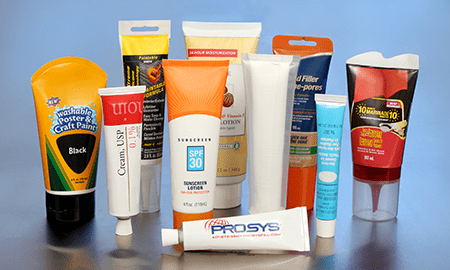The typical plastic tube manufacturing process is composed of the following steps:


- Extrusion
- Heading
- Decorating
- Cappng
The first phase of the manufacturing process is extrusion. A mixture of resin and color concentrate is placed into an extruder hopper. The extruder is temperature controlled as the resin is fed through to ensure proper melt of the resin.
The material is extruded through a set of sizing dies that are encapsulated within a right angle cross section attached to the extruder. At this point, the sleeve is water-cooled and ready for cutting. The sleeve is fed through a set of dies at which time it is sliced to a given length by a rotating knife. The balance of the manufacturing process can be accomplished in one of three ways.
The most common method in the U.S. is the “downs” process of compression, molding the head onto the tube. In this process, the sleeve is placed on a conveyor that takes it to the heading operation where the shoulder of the head is bound to the body of the tube while, at the same time, the thread is formed. The sleeve is then placed on a mandrel and transferred down to the slug pick-up station. The hot melt strip or slug is fused onto the end of the sleeve and then transferred onto the mold station. At this point, in one operation, the angle of the shoulder, the thread and the orifice are molded at the end of the sleeve. The head is then cooled, removed from the mold, and transferred into a pin conveyor.
Two other heading methods are used in the U.S. and are found extensively worldwide: injection molding of the head to the sleeve, and an additional compression molding method whereby a molten donut of resin material is dropped into the mold station instead of the hot melt strip or slug.
The beaded tube is then conveyed to the accumulator. The accumulator is designed to balance the heading and decorating operation. From here, the tube goes to the decorating operation where, with offset printing, flexographics, silk screen and/or cold foil it is decorated. The tube is transferred from the pin chain to a print mandrel. As the tube enters the printer, the first stage is surface treatment, either corona, plasma, or flame treatments prepare the surface of the tube to accept ink. For offset printing, each color transferred onto a central plate by a series of rollers. The plate then comes in contact with a rubber blanket, picking up the ink and transferring it onto the circumference of the tube. The wet ink on the tube is cured by ultra-violet light or heat. For Flexo graphics, silk screen, and cold foil, the inks are applied to the tube surface individually, and an ultra violet like cures the ink after each individual color or foil.
After decorating, a conveyor transfers the tube to the capping station where the cap is applied and torqued to the customer’s specifications. In some factories, the cap is applied first, then decorated, so that the orientation of the front of a flip top closures is aligned with the front of tubes artwork. In either case, the tube is then transferred to a conveyor belt and packed into a tray. The trays are packed into cartons that are sealed and ready for shipment.

